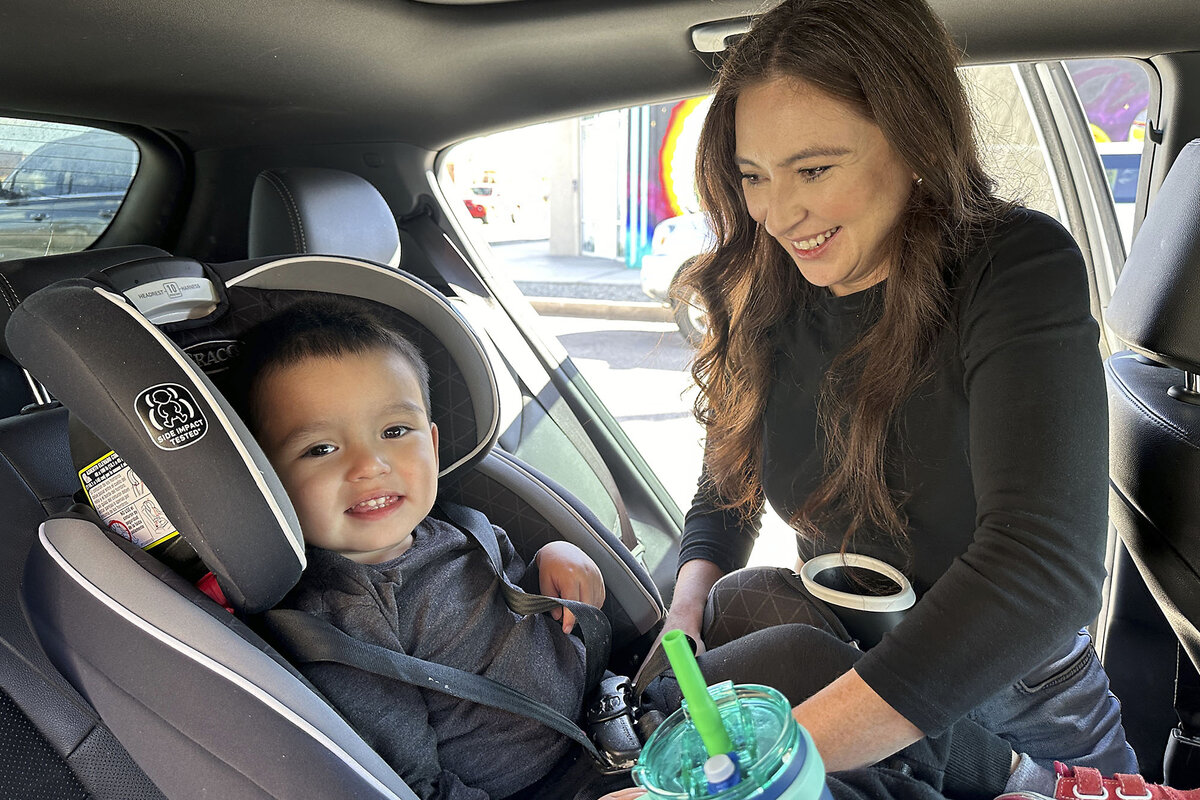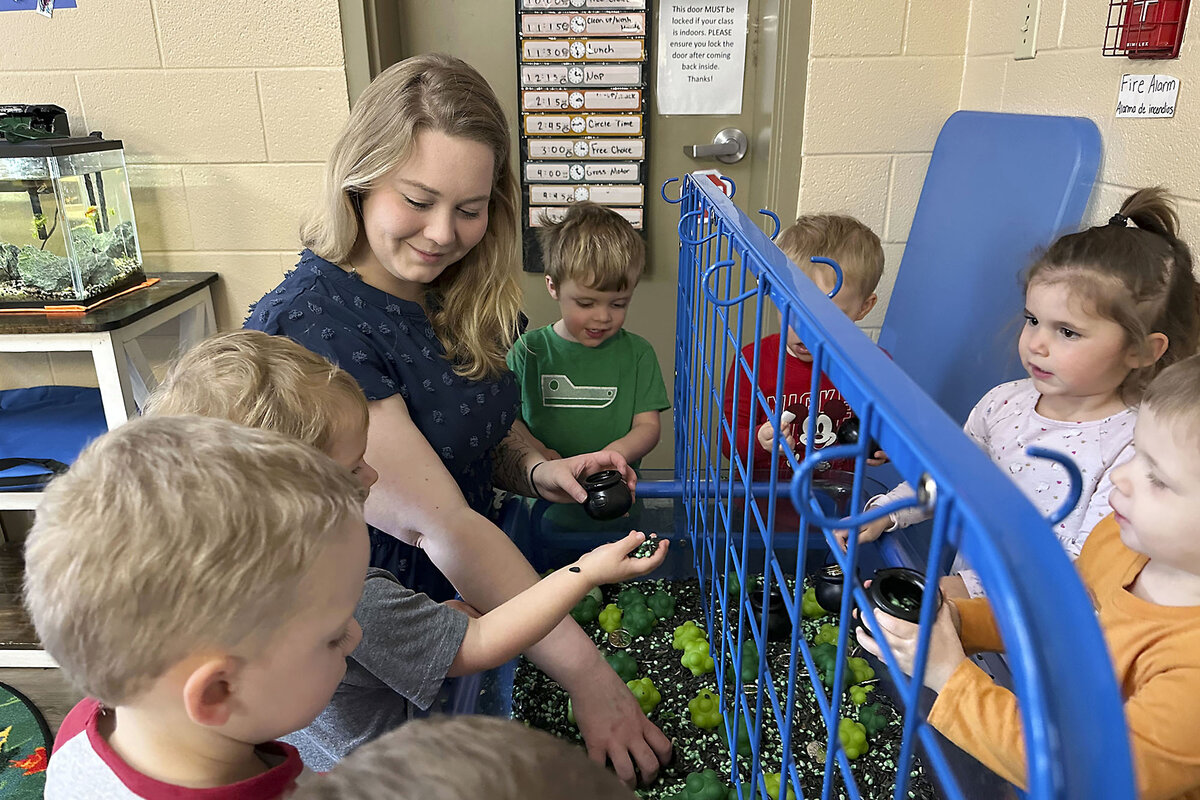Why states are stepping in to help parents with child care costs
Loading...
| ALBUQUERQUE, N.M.
Across the country, the story for families is virtually the same: Child care is unaffordable for many, hard to find for those who can pay, and financially precarious for day care operators and their employees.
The Biden administration and Congress tried to alleviate some of these problems when the pandemic took a toll on the child care industry. But as the record $52.5 billion in relief winds down, many states have stepped in with their own solutions.
States have expanded free preschool and early education and helped more families pay for child care, making it low-cost or even free for many. Recognizing that a federal solution is unlikely anytime soon, policymakers have come up with novel ways to pay for their plans, creating permanent funding sources that will make new programs sustainable.
Why We Wrote This
States are taking action to reduce child care costs for families. Their solutions offer a path for keeping parents in the workforce – and helping local economies. Part of the series, “Fixing the Child Care Crisis,” from the Education Reporting Collaborative.
New Mexico, for instance, has tapped into its petroleum revenue, Washington state put a new tax on investment profits, and Kentucky is incentivizing parents to become child care workers.
And while the largest investments in child care have come from Democrats, Republican state lawmakers across the country are embracing plans to support child care – citing the importance to the economy.
New Mexico funding makes careers possible
After she gave birth, Marisshia Sigala put on hold plans to start her real estate career. She and her husband – a personal trainer – lived on one paycheck for about two years and realized the cost of child care would be out of reach even if both were working.
Then, in 2022, New Mexico made child care free for nearly all the state’s families, amending the constitution to fund early childhood initiatives with money from leasing state land to oil and gas companies.
The change will bring in an estimated $150 million a year for the early education of children like Mateo. Ms. Sigala and her husband qualify because they earn less than 400% of the federal poverty rate, currently about $120,000 a year for a family of four. Mateo is one of more than 21,000 children now benefitting from the subsidies.
Now Ms. Sigala is back at work while Mateo attends Koala Children’s Academy, which specializes in bilingual education.
“Being entrepreneurs, it’s a lot more challenging, and we have to rely on ourselves. We don’t have a paycheck coming in every week,” Ms. Sigala says. “It’s been a blessing for us.”
Expanding free child care for families is “making a difference for families in such a profound way,” says Elizabeth Groginsky, New Mexico’s early childhood education secretary. And, she says, it’s helping the people who care for and educate young kids, too.
Ms. Groginsky and other state leaders are hoping the massive investment will help blunt the effects of poverty.
“It’s just a really incredible opportunity we have here,” she says.
Preschool for families in Washington
Washington state is aiming to offer free preschool to all low-income families, and child care vouchers to all low- and moderate-income families by the end of the decade, along with high-quality care for infants and toddlers with developmental concerns.
The state is expanding its programs with help from a new 7% tax on profits made from residents’ financial investments – a levy intended to fall on wealthier people.
When Zaneta Billyzone-Jatta’s daughter Zakiah was born prematurely in 2021, her mother hired a nanny to watch the baby three days a week. A clinical manager for a hospital network, Ms. Billyzone-Jatta had to work while keeping an eye on her daughter the other two days. She felt like she couldn’t give her toddler enough attention, much less address the girl’s developmental concerns like a professional could.
Through a state program for low-income families and kids with challenges like Zakiah, she now sends her daughter to a child care center near her Seattle-area home, free of cost. There, three teachers supervise seven children in Zakiah’s class and diligently document her progress. Occupational and speech therapists see Zakiah at the school and work closely with the teachers.
Ms. Billyzone-Jatta says Zakiah has made huge strides at the school. She talks about her days in detail and refers to classmates by name. She has learned to interact with other students, drink from an open cup and share.
“Being a working mother and being able to know that you’re bringing your child to an environment where they’re loved and cared for gives you so much peace,” Ms. Billyzone-Jatta says.
But the program helping infants and toddlers like Zakiah is still small, serving fewer than 200 children statewide. And in November, Washington voters will have a chance to weigh in on the tax in a referendum that could lead to its repeal, endangering the progress the state has made, child care advocates say.
“It would be catastrophic,” says Jon Gould, of Akin, the nonprofit that operates Zakiah’s state-supported child care center.
In Kentucky, kids of child care workers attend free
Rilee Monn was working at Baptist Health Child Development Center in Lexington when she had her second child, doubling what she paid for her children to attend the same center.
She thought about quitting and getting a night-shift job so she could stay home and care for her children during the day.
“All of my paycheck was going to child care,” Ms. Monn says.
Then, in 2023, Kentucky started a program to cover or reduce the cost of day care for parents who work in the child care industry. The program was meant to tackle two challenges at once. Policymakers hoped it would draw more workers into the child care industry, addressing a shortage. And they wanted to provide more low-cost child care for all families.
Now, more than a dozen states are considering or have already adopted policies modeled after the one in Kentucky, according to EdSurge, a publication that focuses on education.
The program has helped the state’s child care industry recruit workers who might otherwise be working in service jobs.
Delaney Griffin was working in a pizza restaurant last year and pondering her next move with her young family. Her child care costs consumed all but $100 of her biweekly check.
After learning about the child care benefit, she took a job in December with Baptist Health Child Development Center. She now pays about $5 a week. Her older child is in a preschool program.
“The free child care part was like the biggest reason that I actually got to start in child care,” she says.
This article, part of the series “Fixing the Child Care Crises,” was produced by the Education Reporting Collaborative, a coalition of eight newsrooms that includes AL.com, The Associated Press, The Christian Science Monitor, The Dallas Morning News, The Hechinger Report, Idaho Education News, The Post and Courier in Charleston, South Carolina, and The Seattle Times.
Previous articles in the series:
May 7: ‘I can be mom and teacher.’ Schools show appreciation by providing child care.
April 30: These cities raised taxes – for child care. How it’s changing parents’ lives.
April 22: The US child care system is in crisis. It’s hardest on moms without degrees.









